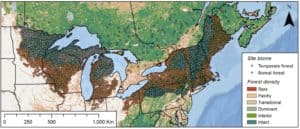“Analyzing large amounts of field data from 18,500 forest plots – from Minnesota to Maine, and Manitoba to Nova Scotia – the study identifies priority regions for forest climate adaption efforts.”
A study funded by the Forest Service found that older forests in eastern North America are less vulnerable to climate change than younger forests in terms of the sensitivity of carbon storage, timber volume and species richness. From the abstract (linked to this news release):
We found the strongest association among the investigated ESB indicators (ecosystem services and biodiversity) in old forests (>170 years). These forests simultaneously support high levels of carbon storage, timber growth, and species richness. Older forests also exhibit low climate sensitivity of associations among ESB indicators as compared to younger forests. While regions with a currently low combined ESB performance benefitted from climate change, regions with a high ESB performance were particularly vulnerable to climate change. In particular, climate sensitivity was highest east and southeast of the Great Lakes, signaling potential priority areas for adaptive management. Our findings suggest that strategies aimed at enhancing the representation of older forest conditions at landscape scales will help sustain ESB in a changing world.
Some of this sounds a little contradictory (maybe someone with more expertise and/or who reads the full article could explain), and I wonder if it has any application at all to more fire-prone forests. But it is a different way of looking at climate change adaptation that could be incorporated into forest planning.

I can’t speak about all these areas as the ecologies are different and rapidly changing there. I spent a long time in the southern end of NJ and got to know the forest there fairly well. It’s a prescribed burn area where the forest doesn’t really ever “grow up” fully to the level where underbrush is largely absent. But there are a few places that are very sandy with pines hanging on to the margins. Some of the pines, especially in Lebanon State Forest (NJ) are serrotinous, so they don’t release seeds except in certain conditions, like fire. Since the soil is already very sandy, I’d expect that climate pressure would cause desertification there. The “upland” forest is older and has higher biodiversity with a predominance of oak over pine, and an under story of maple and sometimes cypress or beech. And there are several swampy areas, often with tea colored lakes nearby. You could walk in one day through all three of these ecological areas.
Another interesting aspect of southern NJ is the Kirkwood-Cohansey aquifer, one of the few large confined aquifers int he country. A town exists that’s preserved from the 1800s because it was repossessed by the government to ensure the availability of water to the nearby cities. I wish I could remember the name, I thought it was White Oaks, but google is full of news about an ancient white oak that recently died so I couln’t find it. This is the Pinelands Commission and it looks like they haven’t been alerted to the research: https://www.nj.gov/pinelands/science/ Rutgers gets all the press in that area, but Richard Stockton University in Pomona, NJ is also involved in ecology, and much better focused on the local area.
I can’t tell if southern NJ was even part of the area they studied. However, losing such a jewel of ecological diversity would be a heartbreak for many people, not just me.
In my younger years (mid- 70s) as a graduate student, I cleared brush from pitch pine provenance test plantations in the Pine Barrens near the Forest Service lab run by Si Little. Here’s a bit of FS Pine Barrens history. Wonder whether any of those pitch pines made it, or whether the plantation records are lost somewhere in the archives at Yale or ???? Back in those days, we studied genetic variation in forest trees by gathering seed from different places and growing them together in the same locations, usually covering the range of the species.
“In 1937, Dr. Silas Little was assigned to the Lebanon and worked there until 1979, most of that time as the research project leader. This experimental forest was renamed in his honor after his retirement. In 1985, following the departure of the last Forest Service employee, the Northeastern Research Station entered into a cooperative agreement with Rutgers University to use the buildings for the Pinelands Research Center (PRC). In the late 1980s, the site received recognition as a UNESCO Man and the Biosphere site. The PRC has a full-time director, a site manager, and a number of graduate students in residence. In 2002, the Northeastern Research Station reestablished active fire research at the Silas Little with a 5-year National Fire Plan grant for regional climate and fire danger modeling specific to the Pine Barrens. The existing fire danger rating system does not meet the needs of the wildfire managers in this part of the United States and this research will address this deficiency.” Here’s a link: https://www.nrs.fs.fed.us/ef/locations/nj/silas-little/
Jon, I’d like to explain this one but couldn’t find the paper easily for sure by searching as the press release says it’s in the June 12 edition. I searched in the June edition and didn’t find it. https://onlinelibrary.wiley.com/toc/13652486/2019/25/6
It might be this one, https://onlinelibrary.wiley.com/doi/abs/10.1111/gcb.14656 but, if so, why would the press release dated June 7 say that it was expected? Very confusing.**** after some research it appears that this is the citation Volume25, Issue7 July 2019 Pages 2446-2458. I wrote for a reprint so more later.